FAMILY GROUP RECORD OF
MALCOLM MACCALLUM AND
ANNE MAXWELL
Malcolm was born in about 1763 in
Muckairn, Argyllshire, Scotland, the son of Dugald MacCallum
and Anne McGregor. Muckairn is a parish about eleven miles
northeast of Kilbrandon. Muckairn was united with the parish
of Ardchattan in the early 1600s.
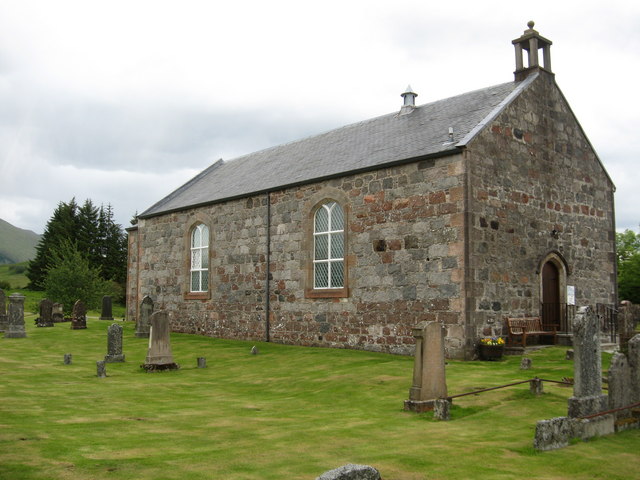
Muckairn
Malcolm married Anne Maxwell in about 1781. Malcolm worked as a crofter and
innkeeper in Kilbrandon parish, then a carter and slate
labourer as he became older. Anne is shown as Agnes at son
George's christening.
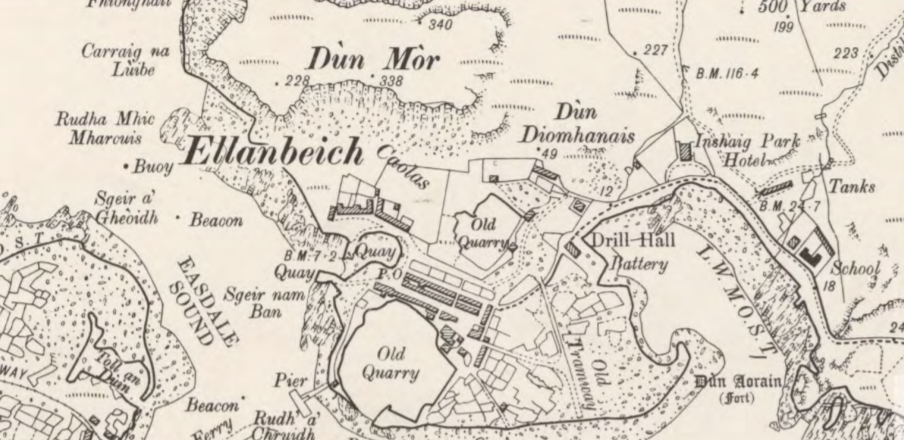
Map of Ellanbeich
Caolas is shown in the center.
In 1787, Malcolm was shown as an
"innkeeper of Caolis" in Kilbrandon parish at his son
John's christening. Caolas is a townland in the village of
Ellanabeich, just across the sound from Easdale Island,
Easdale was the center of the British slate mining industry,
and "Easdale had a community of more than 500 working as
many as seven quarries". (www.wikipedia.com) The
quarries included Easdale, Ellanabeich, and Balvicar. "By
the end of the seventeenth century the Earl of Breadalbane
and his cousin the Duke of Argyll, who between them owned
most of the county and much of Perthshire and Stirlingshire
besides, began to exploit the slate deposits on a commercial
basis and in 1745 a company was formally registered, the
Easdale Marble and Slate Quarrying Company. Villages were
built to accommodate the influx of workers and because of
the dangerous nature of the work a surgeon was appointed to
minister to the men and their families." (The
Easdale Doctor, Mary Withall)
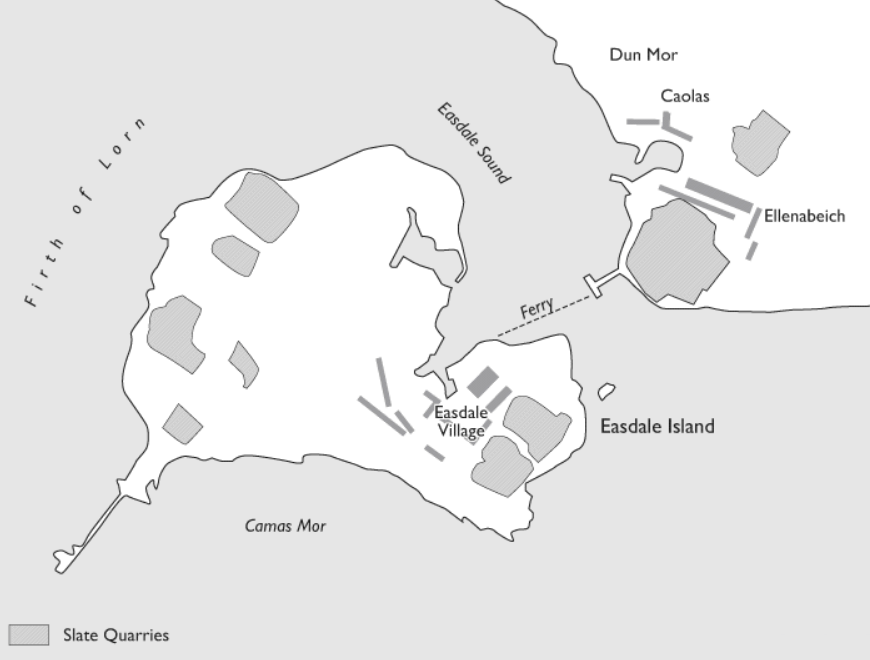
Caolas was described: "in the tiny township of Caolas at
the most westerly point of the Isle of Seil. The settlement
was at the time composed of a few cottages gathered around
the tiny harbour of Easdale and overshadowed by the towering
cliffs of Ben Mor. While Caolas itself had been settled from
earliest times, in the first two decades of the nineteenth
century the village had been enlarged to accommodate a
growing population of quarry workers. The quarrymen and
their families were housed in three rows of terraced,
whitewashed cottages whose harled stone walls and slated
roofs were a match for anything the elements might send
against them. In winter these houses are swept by gales from
the north and west and the shores beside them are pounded by
the Atlantic Ocean." (The Easdale Doctor)
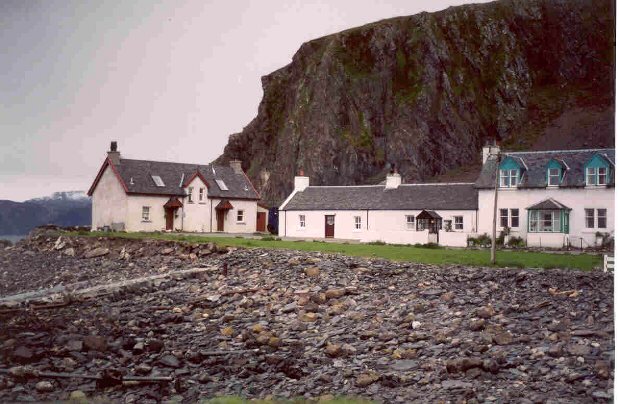
Caolas with the cliffs of Dun Mor in the background
In 1792, Malcolm and Anne are
shown as of "Balvicar" in their son George's
christening. "Balvicar is a village on the island of
Seil, a small island 7 miles southwest of Oban, Scotland.
It is one of three villages on the island along with
Ellenabeich and Clachan-Seil." (www.wikipedia.com) Balvicar
was a former slate mining village on the island of Seil.
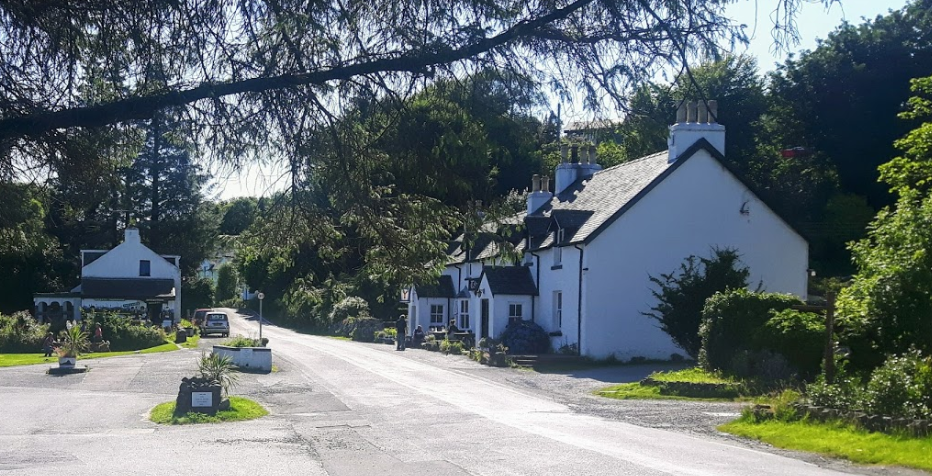
Balvicar
In 1834, a list of the male
heads of households was taken in Kilbrandon parish. Malcolm
does not appear on this list, but two MacCallums are listed in
Ellanabeich. They may be his family.
Alexandr Mccallum Ellanabeich
Dougald Mccallum
Ellanabeich
(Male Heads of Families,
1834; www.oldscottish.com)
Malcolm is found in the 1841 census in Kilbrandon,
in the village of Easdale. "Easdale is one of the
Slate Islands. The Slate Islands are an island group in the
Inner Hebrides, lying immediately off the west coast of
Scotland, north of Jura and southwest of Oban. The main
islands are Seil, Easdale, Luing, Shuna, Torsa and Belnahua.The
underlying geology of the islands is Dalradian slate, which
was quarried widely until the mid-20th century. Quarry working
began in 1630 and at the turn of the 20th century, the
quarries were yielding some eight million slates every year."
(www.wikipedia.com) "Once
all the available slate had been removed to sea level, the
men began to dig down into the ground following the dip of
the tilted slate beds. Over a period of two hundred years or
more the quarrying reached depths of as much as seventy
metres below sea level. Keeping the quarries dry while the
men were working required both ingenuity and perseverance
from the engineers who ran the quarries. When work finally
ceased at the beginning of the twentieth century these great
pits in the ground quickly filled with water, creating a
landscape dotted with deep, tranquil pools surrounded by
heaps of waste slate." (The Easdale Doctor)
Easdale was both an island and a village: "A hundred and
fifty metres off shore, the island of Easdale sported a fine
harbour of its own and a village of quarry workers’ houses
which had been built a quarter of a century earlier than
those on Seil. Easdale Island accommodated some four hundred
and fifty people in 1870 while the population of Easdale
Village on Seil was around three hundred. Because the whole
district was called Easdale, the two settlements came to be
known as the Island and the Village, and, although the
manager of the quarries was responsible for the work of
both, the inhabitants set themselves apart from one another
as though they might be two different nations." (The Easdale
Doctor)
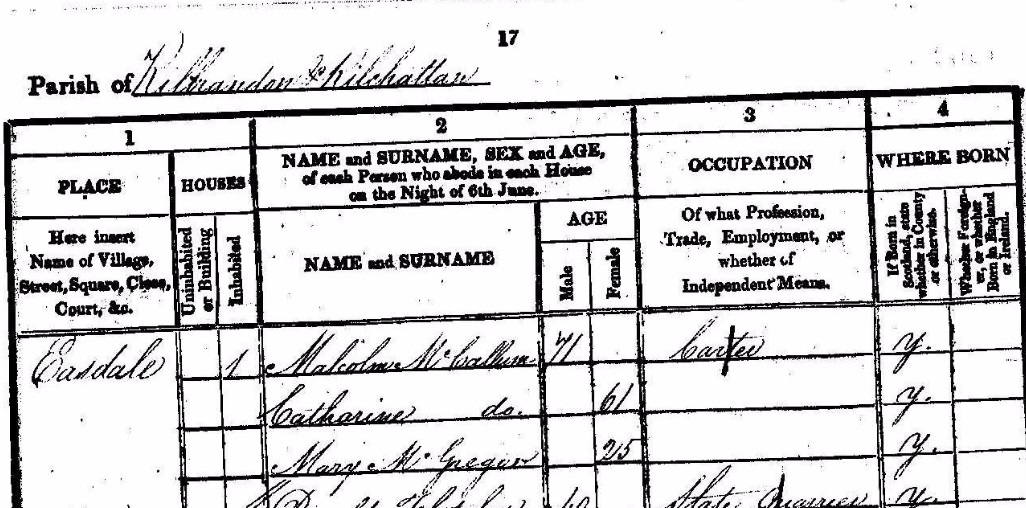
1841 census, Kilbrandon
Easdale Malcolm McCallum, age 71, carter, born in the county
Catherine McCallum, age 61, born in the county
Mary McGregor, age 25, born in the county
It seems that Anne has died, and Malcolm has
married Catherine.
In the 1851 census in Kilbrandon, Malcolm is found living with
Joseph and Anne MacLean.

1851 census, Kilbrandon
Ann MacLean, wife, age 37, born Kilmore
Catherine MacLean, daughter, born Kilbrandon
Jessie MacLean, daughter, born Kilbrandon
Joseph was Malcolm's nephew-in-law. Joseph married Ann McGregor, Malcolm's niece. Ann is shown as being "of Kilninver" at her marriage 30 November 1845 in Kilbrandon.

Death certificate for Malcolm MacCallum
Malcolm died 24 April 1856 in Kilbrandon. His nephew Joseph McLean was present at his death.
Malcolm McCallum, slate labourer, widower
Died 24 April 24, 1 h. 0 m. a.m., Easdale
Male, 94 years
Parents: Dugald McCallum, farmer, deceased, Ann McCallum, maiden name McGregor, deceased
Cause of death: Infirmity, as certified by Wm Gordon, MD, who saw deceased April 22d
Where buried: Churchyard of Kilbrandon, as certified by Joseph McLean, nephew
Registered: 24 April 1856 at Kilbride, Seil, Alex. McMillan, Registrar
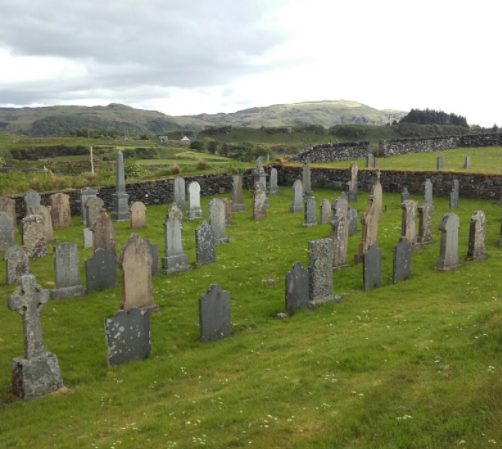
Kilbrandon churchyard
Malcolm and Anne had the following children:
1. John, christened 27 January 1787 in
Kilbrandon: "John son to Malcom MacCallum Inkeeper
at Caolis and Ann Maxwell his wife was born 27 January 1787".
2.
George, christened 10 July 1792 in Kilbrandon: "George
son to Malcom MacCallum and Agnes Maxwell, Balvicar".
*3. Catherine,
born about 1793 in Kilbrandon; married Alexander Cameron 9
December 1813 in Kilmelford; died 18 March 1862 in Strachur. Her
death certificate listed her parents as Malcolm MacCallum and
Anne Maxwell.
SOURCES: Kilbrandon parish register; FHS# 102373; www.scotlandspeople.org; 1841 census, Kilbrandon; 1851 census, Kilbrandon; Death certificate for Malcolm MacCallum; The Easdale Doctor, by Mary Withall.
DUGALD MACCALLUM AND
ANN MCGREGOR
Dugald
MacCallum was born in about 1730 of Muckairn, Argyllshire. He
married Ann McGregor (also known as Ann McIntyre). Muckairn is a
quoad sacra parish in the civil parish of Ardchatten. The name
in Gaelic means "the den of the wild boars".
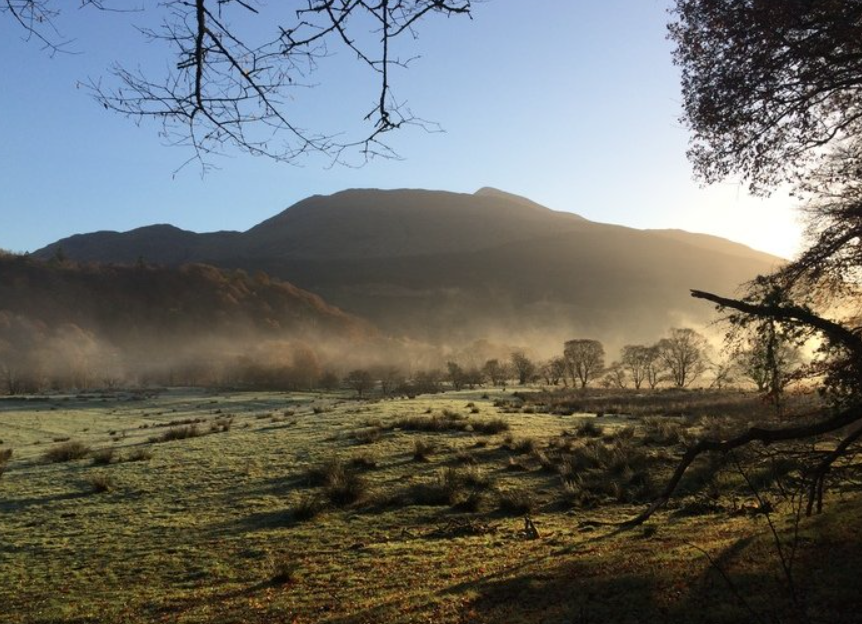
Muckairn
The
nearest town to Muckairn is Oban, which is twelve miles west.
Dugald
is found in the Farm Horse Tax roll of 1797-8 in Ardchattan and
Muckairn:

Farm Horse Tax List 1797-8
The
list shows:
Dugald
MacCallum, Laitt 2 2 4
(Later, in 1834, Duncan, John and Gregor McGregor are listed in Laitt in a census of male heads of household. Possibly these are Ann's family.)
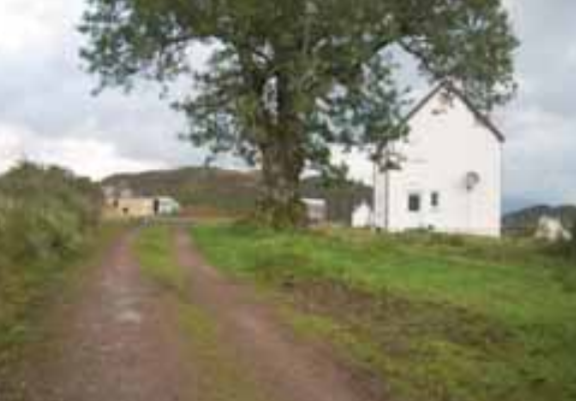
Lailt in Muckairn parish
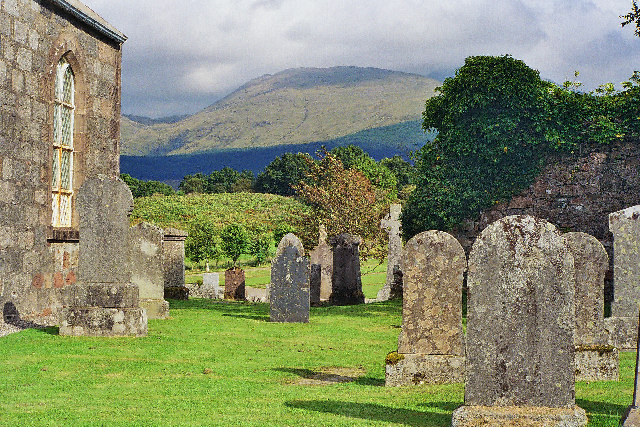
Muckairn
Dugald
and Ann had the following children:
1. Katarine,
christened 12 January 1760 in Ardchattan (christened as the
daughter of Dugal MacCallum and Ann McIntyre).
*2.
Malcolm, born in about 1767 in Muckairn; married Anne
Maxwell; died 24 April 1856 in Kilbrandon.
SOURCE:
Farm Horse Tax Roll 1797-8, Ardchattan and Muckairn,
www.scotlandsplaces.com; Death certificate for Malcolm
MacCallum.
Other early MacCallums in Muckairn were:
- John MacCallum and his wife Ann MacCallum, who had children baptized in Muckairn: Duncan (1754), John (1756), and Donald (1766).
- Archibald MacCallum and his wife Mary MacPherson, married 9
March 1759 in Ardchattan, who had a son baptized in Muckairn:
John (1766). A descendant said that there were other children:
Donald, Archibald, and Malcolm. (www.genealogy.com)
- Malcolm MacCallum and his wife Catharine Colquhoun, who had children baptized in Muckairn: Marion (1774) and Mary (1776).
- Duncan MacCallum and his wife Catharine Campbell, who had a daughter baptized in Muckairn: Mary (1773)
- John MacCallum married Margaret MacInnes 30 October 1774
In 1774, Janet MacCallum is shown in Muckairn as the mistress of
a spinning school, and paid a salary of 3£. (An Account of
the Society in Scotland for Propagating Christian Knowledge,
1774)
John MacCallum, born Muckairn, served in the 91st Foot
Regiment, discharged at age 48, (born 1768), served as a
corporal. He was 5 feet 10 3/4 inches tall, had dark brown hair,
gray eyes, and fair complexion, by trade a labourer. He enlisted
at age 26, and served in the regiment for 22 years. He was
discharged as a consequence of "being worn out".
(nationalarchives.gov.uk)
The Farm Horse Tax Roll 1797-8 showed two additional
MacCallums in Ardchattan and Muckairn, in the townland of
Achnacreemore - John and Archibald MacCallum. (www.scotlandsplaces.gov.uk)
Censuses taken of male heads of household in 1834, 1835, and
1836 listed John and Malcolm MacCallum in Airdeny, Archibald and
Alexander MacCallum in Bay, Duncan, James and John MacCallum in
Airds and Particles, Hugh MacCallum in Culnadaluch, and Duncan
MacCallum in Achlevan.
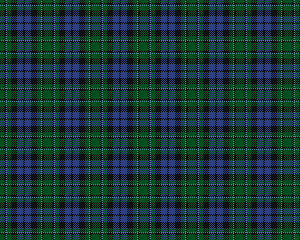
Clan MacCallum tartan
The clan name MacCallum literally means “bald dove”, and indicates a priestly follower of St. Columba, whose sign was the dove of peace. The MacCallum lands are in Argyll. The name is sometimes Malcolm. The clan motto is: “He has attempted difficult things” and “God is our refuge”. The clan tartan is blue and green, and the plant is the mountain ash.